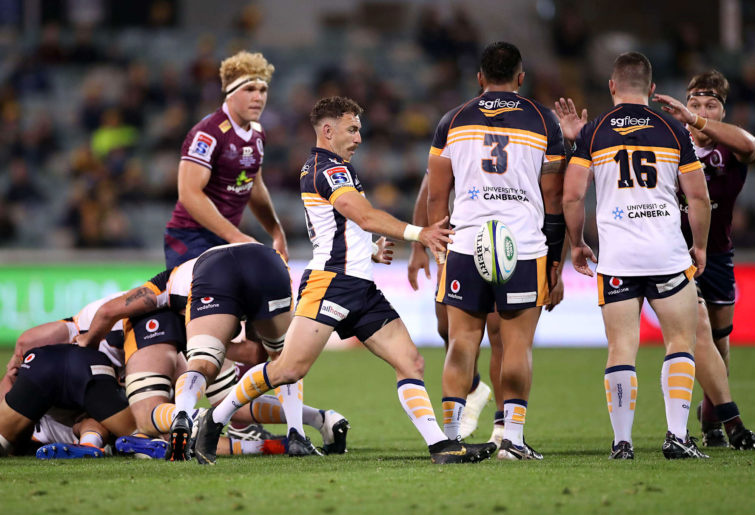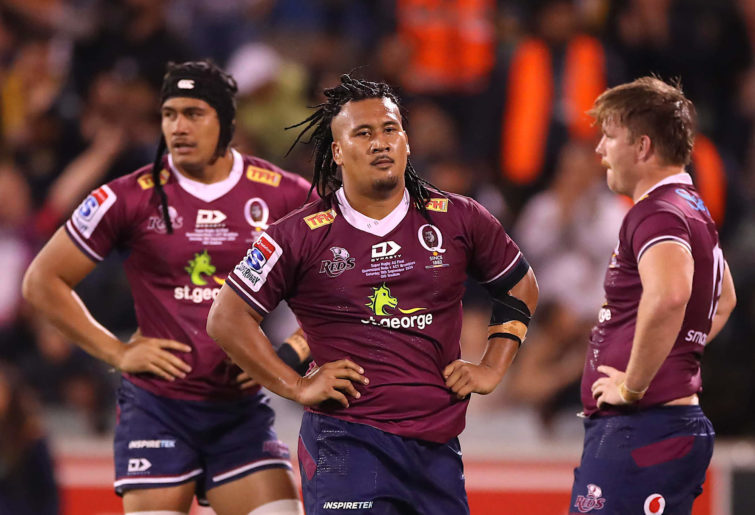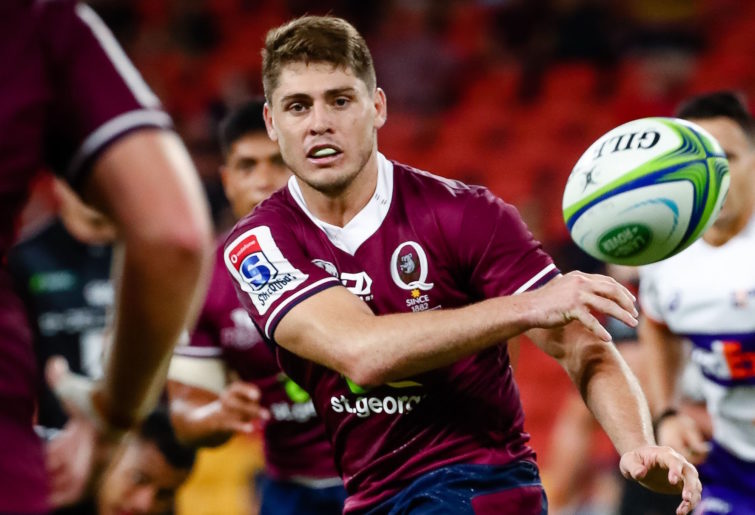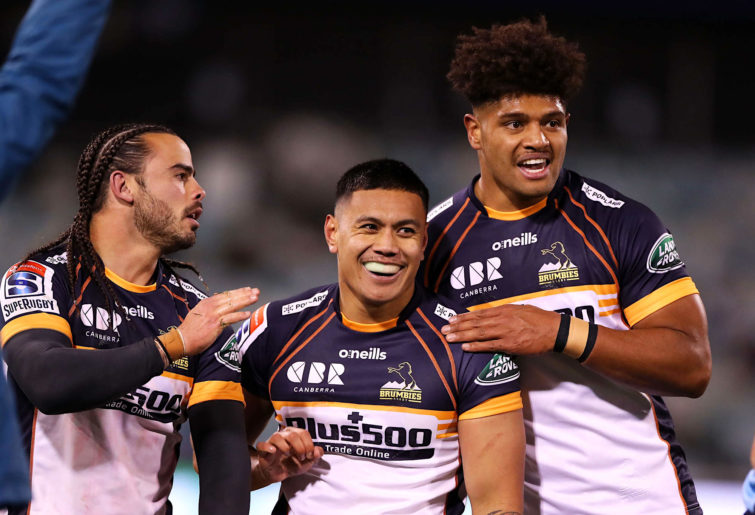Following Part 1, this is the second part of my analysis of the Brumbies.
There’s plenty that would argue that coaches don’t have a major influence on technique and skill development, but you only have to look at the massive difference that Damien Hill has made to the Brumbies’ kicking and goal kicking this season to throw that argument out the window.
Noah Lolesio has gone from a 61 per cent pop gunner to 81 per cent with an improved range of around 45 metres.
Lolesio wouldn’t be doing any more kicking per week than he has over the past five or six years. But it’s the quality of work that he has been doing and the fact that he is working with a very good kicking coach with runs on the board that is making the difference.
There’s plenty of snake oil on social media promoting ‘rodeo arms’, ‘run through the kick’ or abstract phrases like ‘staying in the kick’ and ‘less is more’.
There are some clear changes to Lolesio’s technique from previous years that essentially eliminates redundant movements. The statistical result is Lolesio kicking at over 80 per cent in 2021 and the Brumbies as a whole 85 per cent.
Goal kicking has won them at least two games this year. It is important to note that they also have two accurate long-range kickers in Ryan Lonergan and Nic White, which creates further pressure on teams to be disciplined from 60 out.

(Photo by Cameron Spencer/Getty Images)
They have gone from having one of the worst goal kicking percentages in Super Rugby in 2020 to having the best, including the New Zealand teams in 2021.
The other important thing to note, which further highlights the improvement in this area, is where the Brumbies’ kicks have been taken from. Over 80 per cent of their kicks have been from the width of the field or well over 40 metres. They’ve also only gone for ten penalties thus far for a return of nine and two of these were well over 50 metres.
Reds aren’t exactly slouches in this area either – 83 per cent. They have the same accuracy for penalty kicks, 90 per cent, but they are lower for conversions, 78 per cent. They go for more penalty kicks though and the Brumbies are the most penalised team in the competition. They will see this as an opportunity to accumulate points.
While the Brumbies have only attempted ten penalty kicks in 2021, we saw in the last game against the Force that they were prepared to take the easy points when on offer. Early in the competition they were able to generate momentum coming out of their 22 through contestable kick-and-chase pressure.
That often resulted in cheap opposition turnovers or penalties through set-piece execution and pressure. They’ve been able to derive game rhythm from this as it’s piggy-backed them into the opposition 22 where their execution has been excellent.
The scrum for penalties option won’t be available to them, but the Reds will still need to be disciplined, as it’s from this zone that they look to pin teams in their 22 and roll out their attacking zone options.
For this game though, with accurate goal-kicking options from 60 out, I wonder whether they may take the points when they’re on offer?
Akin to a cricket match with a disintegrating pitch, the coin toss for this game will be relevant. Nic White has developed a long, accurate, contestable restart. That places teams under huge pressure to exit. The Brumbies have given a clue to how they want to play the game through the selection of Nick Frost at six.
Three genuine defensive options who are all 200 centimetres plus is akin to the Springboks’ lineout. It also gives them four genuine targets in attack.
The Brumbies are a set-piece team. Over 80 per cent of their tries are start at set piece and their whole system starts with set-piece dominance. If the Brumbies win the toss, they will kick, with the ultimate goal of achieving a Brumbies lineout throw in the Reds half. That sets them up from the get-go. Sixty per cent of their tries start from the lineout.
While their set piece dropped off over 2019 and 2020, with head coach Dan McKellar looking after the lineout again, it’s back to being the dominant feature of their game. Dan Palmer is back looking after the scrum.

Dan McKellar. (Photo by Kerry Marshall/Getty Images)
I’ve previously mentioned Laurie Fisher’s instincts. In late 2011 he recognised that in Dan Palmer (then 24), he not only had a future Wallaby, but a scrum technician with more knowledge than most international coaches. Rather than be insecure about this, he enabled an environment where Palmer’s strengths could be utilised.
Despite having the world-class Palmer back in charge of the scrum, the past two years where he wasn’t involved, the scrum unfortunately stagnated. Conversely, and to the Brumbies’ detriment, during the same period, the Reds’ scrum has developed into a weapon.
With the Brumbies’ system being so dependent on set piece as the origin, this hurts them. Despite Palmer’s abilities, unfortunately it’s like he’s starting from a record back marker in the Stawell Gift.
The scrum and individual scrum strength, technique and tactical acumen takes significantly longer to develop other skills. It’s not a natural thing to place your head in an environment where your main sense – sight – can be your most irrelevant, all the while managing forces that can be cumulative and/or coming and changing constantly from different directions. The basic human instinct of see, perceive and react can not only be irrelevant but detrimental in this setting.
The Brumbies will have cued the referee and their assistants up for Taniela Tupou starting on the angle. They’ll be sowing the seed that he does it in every scrum.
With Frost at six, I’d also be interested to see whether he scrummages predominantly on the loosehead side. He’s a big body, plus preparing for and playing predominantly lock up until this point, he will also be better technically that Rory Scott.
Further, I’d imagine that they will aim to upset the connection between Tupou and Brandon Paenga-Amosa so that they can isolate Tupou against his opponents.

(Photo by Mark Kolbe/Getty Images)
I could be speaking rubbish and this is easier said than done.
Either way, up until this game, over 20 per cent of the Brumbies’ tries have started with the scrum. But also, outside of the Reds and the Force last start, they have also been able to generate penalties through their scrum – particularly between the 22s, which has allowed them to go to their real strength: the lineout.
They won’t have this luxury in this game. The Reds have an advantage.
The Brumbies, particularly early in the competition, were able to generate a lot of penalties between their own ten-metre line and the opposition 22 and I’d argue that this is where they generate both momentum and game rhythm from. Their opposition 22 outcomes often start from what occurs in this region of the field.
White has the longest contestable box kick in World Rugby, so their predominant exit strategy from their own 22 or half has been to kick then put massive pressure on the opposition aiming for a mistake, penalty or turnover. Over 40 per cent of their kicks are high ball contestable kicks from the scrumhalves in this region. Added to that, when the ball is kicked back to them a large portion of their options are to put the ball back in the air again and repeat the process.
Sports opinion delivered daily
function edmWidgetSignupEvent() {
window.roarAnalytics.customEvent({
category: ‘EDM’,
action: ‘EDM Signup’,
label: `Shortcode Widget`,
});
}
That said, I wonder though, with the selection of Frost at six, whether they may look to kick out from their 22 in this game.
Adding further intrigue to the Frost selection is the maul. Every game, teams have been defending the maul better. Their driving maul is usually set up off one of the locks. Frost will have had plenty of reps in that role over the past three years. Consequently, they will have with a third and deeper point in the lineout to maul from.
The Reds would have done most of their preparation on either Darcy Swain or Cadeyrn Neville as the targets. They’ll be scrambling late to work out how they can nullify an option in a position that they haven’t seen yet.
As highlighted, the Brumbies are a set-piece team and dominance through this sets them up in developing momentum. They’re not going to get scrum dominance and there have been signs that if sides can upset their rhythm and execution in this area of the field, it can potentially affect their overall game.
Given their predominant, systemised, contestable exit strategy up until this point, I’d be very surprised if the Reds don’t try to use their more expansive kicking game to pin them in their own 40 metres.

(Photo by Patrick Hamilton / AFP via Getty Images)
Both the Highlanders and the Chiefs were able to upset the Crusaders through generating field position and pressure via finding grass kicking from flyhalf in this area of the field.
James O’Connor has developed a wide variety of attacking kick and field position options and they have kicking options from nine to 15. Adding weight to this is that, despite having very good runners in the back three, the Brumbies don’t really exhibit any great counter-attacking strategy.
Only 14 per cent of their tries are scored on the counter. When they do run, it’s more about setting them up for the attacking system, rather than looking for immediate opportunities to take advantage of errors in chase alignment and back-field positioning. Even off turnover ball, their first option is to kick long to space and aim to force a poor opposition kick to the sideline.
On the flip side, the Reds are the opposite – they have more attacking options and change-ups. If there’s space in the back field, they’ll kick, either deep or short. If there’s space in the front line, they’ll attack with the ball in hand.
The Brumbies do have players with reasonable attacking kicking games: Lolesio, Len Ikitau and Andy Muirhead. Ikitau has the benefit also of being a left footer. But the bulk of their attacking kicks have been in the opposition 22 and we haven’t really seen any kick-pass options in 2021.

(Photo by Mark Kolbe/Getty Images)
The Brumbies’ strength – the lineout – is the Reds’ weakness. The addition of Frost is to throw more eggs in this basket. Paenga-Amosa is a poor lineout thrower, which is hard to fathom as it’s a closed skill.
He’s also not aided by the fact that a number of the Reds jumpers jump or are lifted across the line. Again, expect the referees to be cued up for this, as in the last game there were at least three throws that could have easily been called for not being straight.
Remember, compounding penalties at the set piece or between the 22s seems to fuel the Brumbies. If they get multiple lineouts in opposition 22 metres, the harder it is for teams to compete. Expect some fairly aggressive body language and visual and verbal distractions being thrown at Paenga-Amosa every single time he lines up to throw.
The Reds obviously recognise where the Brumbies’ strengths lay. The selection of Angus Scott-Young at six over captain Liam Wright is about a few things. Firstly, Scott-Young is the Reds’ primary lineout caller. Secondly, by having him in the second row, it leaves them with one tall lineout option (Lukhan Salakaia-Loto) and three short options (Harry Wilson, Wright and Scott-Young).
This is not unmanageable, but it creates a greater advantage for the Brumbies’ strength. Also, given he has hardly played lock this year, playing him at lock weakens the Reds’ weapon: the scrum.
The Reds are a much more balanced team with two genuine locks and Scott-Young at six.
Original source: https://www.theroar.com.au/2021/05/08/are-the-brumbies-about-to-lose-their-mantle-as-australias-no-1-team-part-2/
source https://therugbystore.com.au/are-the-brumbies-about-to-lose-their-mantle-as-australias-no-1-team-part-2/
No comments:
Post a Comment